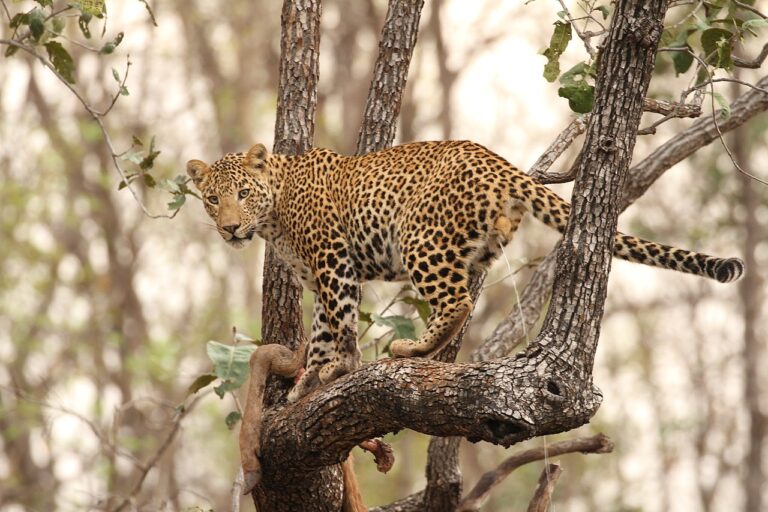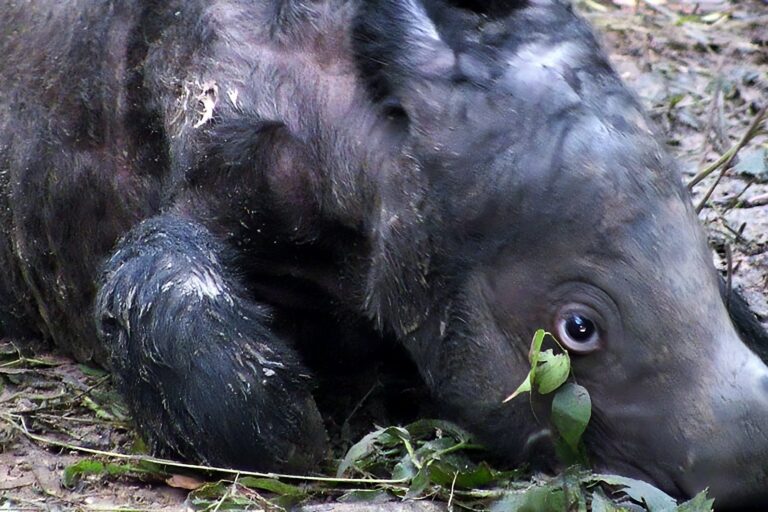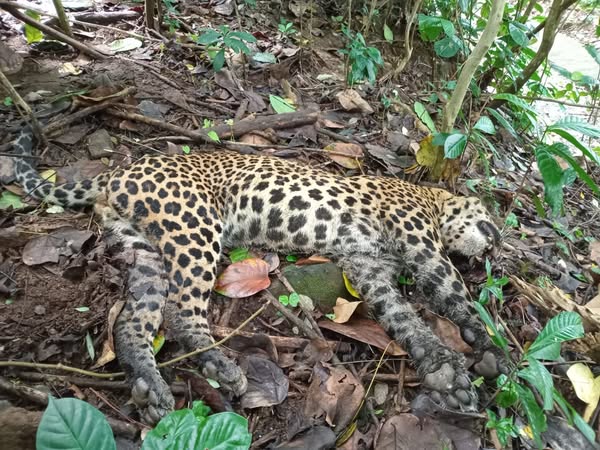- After a poaching crisis, Javan rhino numbers have dropped by a third.
- Sumatran rhino estimates remain the same — on the edge of extinction.
- Still, recent developments provide a little good news for both species: recent births for Javan rhinos and a potential surviving population in southern Sumatra for Sumatran rhinos.
A new report by the IUCN finds that two of the world’s most endangered species are still perilously close to extinction. Javan rhino (Rhinoceros sondaicus) numbers have dropped by a third, from 76 animals to just 50 after local poaching groups allegedly wiped out 26 animals, mostly males. Meanwhile, Sumatran rhinos (Dicerorhinus sumatrensis) remain at just 34-47 animals, making them the most threatened rhino, and one of the most imperiled animals, on the planet.
The Javan problem
Despite the disappointing numbers, Nina Fascione, the executive director of the International Rhino Foundation, says the situation is not hopeless for either species.
“Javan rhino numbers have been low before,” Fascione says. In 1967, the first survey showed only 26 animals. Javan rhinos have a single horn and are mostly closer related to the larger, single-horned rhino, the Indian rhinoceros (R. unicornis).
“Conservationists, the government of Indonesia … have all worked very hard to bring them back. It’s slow going, and rhinos obviously have a long gestation period, but it has been done before,” Fascione says. “We can do it again.”
Javan rhinos, today, are found in a single national park: Ujung Kulon. The population had been steadily, if slowly, rising in recent decades. Until poachers came.

In 2023, rangers in the park discovered missing camera traps, according to the report.
“Footage from remaining cameras later showed armed individuals in the park,
apparently tracking rhinos,” reads the report.
Eventually, police arrested 13 poachers and traders from a nearby village involved in the slaughter of the rhinos for their horns. The poaching crew focused on males due to their larger horns, skewing the sexual ratio and setting back conservation efforts for years.
The incidents raised questions about security in the park. How could these poachers have acted in the park for so long and killed so many rhinos given the ranger presence? Fascione says many security changes have been made.
“There are a lot of new measures in place that didn’t exist a couple of years ago when the poaching was happening. …The world’s attention is on the species. I do feel confident that we’re in a better place than when the poaching occurred,” she says.
Still, Fascione adds that there is no foolproof regimen against poachers, who are “creative and bold,” given the payout for rhino horn. Rhino horn is used in Chinese traditional medicine and, increasingly, as a status symbol in parts of Southeast Asia.
But the news isn’t all bleak for Javan rhinos.
“The good news is there have been six Javan rhino calves born in just the past two years. … They’re doing what they need to do,” Fascione says. “We need to protect them.”
The government is also discussing setting up a captive breeding program for Javan rhinos — similar to what they’ve done for Sumatran rhinos — to provide an insurance program for the species.
There has also been talk for decades of setting up a second wild population for Javan rhinos, with no action taken. Given the population plunge, that idea is not a priority right now, Fascione says.

On the edge: Sumatran rhinos
Disappointingly, Sumatran rhino estimates remain stable after three years: Just 34-47 animals are believed to remain in the wild. Of all the rhino species, the Sumatran rhino numbers are the least certain, given the same number of animals, the rugged and remote terrain and their famous elusiveness.
“[The numbers are] an estimate, and that’s all we can do,” Fascione says.
Sumatran rhinos, which are the smallest rhinos, are the oldest evolutionarily. They represent their own genus and are the hairiest and nosiest of all the rhinos. They are also the most closely related to the extinct woolly rhino (Coelodonta antiquitatis), which vanished around 14,000 years ago, likely due to human hunting and climate change.
On the plus side, a highly successful captive breeding program for Sumatran rhinos now stands at 11 animals and remains an insurance policy against total extinction.
Of the wild animals, the report estimates that 2-3 animals may survive in Borneo, representing a different subspecies: D. s. harrissoni. Currently, only one is known for certain: a female named Pari. For years, officials have been trying to capture Pari to add her to the breeding program, as she’d bring vital new genetics into the program.
“Pari has been pretty darn elusive,” Fascione says.
The vast majority of wild, surviving rhinos are thought to dwell in northern Sumatra. They were believed to have been wiped out of southern Sumatra in the past decade. However, recent developments have changed this. Dogs with the nonprofit Working Dogs for Conservation have found what is believed to be rhino scat in southern Sumatra — the first direct sign of rhinos there in a long time.

“Our dogs thrive on tough scent challenges like this,” says Crystal Sharlow-Schaefer, director of development of Working Dogs for Conservation.
The rhino scat, which is more than one sample, has passed one test confirming it’s from the elusive Sumatran rhino. It needs to pass two more before conservationists are certain it’s rhino.
“This is brand new. Literally, the dogs are in the jungle right now,” Fascione says. If true, it might prove an additional lifeline for the species. Fascione says she believes any rhino in southern Sumatra should be caught and brought into the captive breeding program, which desperately needs new members, as all the males are directly related.
Fascione says there are a number of ways to help Asia’s last rhinos: Get involved in World Rhino Day (Sept. 22), visit zoos with rhinos (as zoos are very active in rhino conservation) and finally consider donating to expanding the Sumatran Rhino Sanctuary, which houses the captive rhinos. Currently, the sanctuary is at full capacity.
The new report, which drops every three years, was compiled by the IUCN Species Survival Commission’s African Rhino Specialist Group, Asian Rhino Specialist Group and TRAFFIC.
Banner image: A baby Sumatran rhino in June 2012. Image by International Rhino Foundation via Wikimedia Commons (CC BY 2.0).
FEEDBACK: Use this form to send a message to the author of this post. If you want to post a public comment, you can do that at the bottom of the page.














